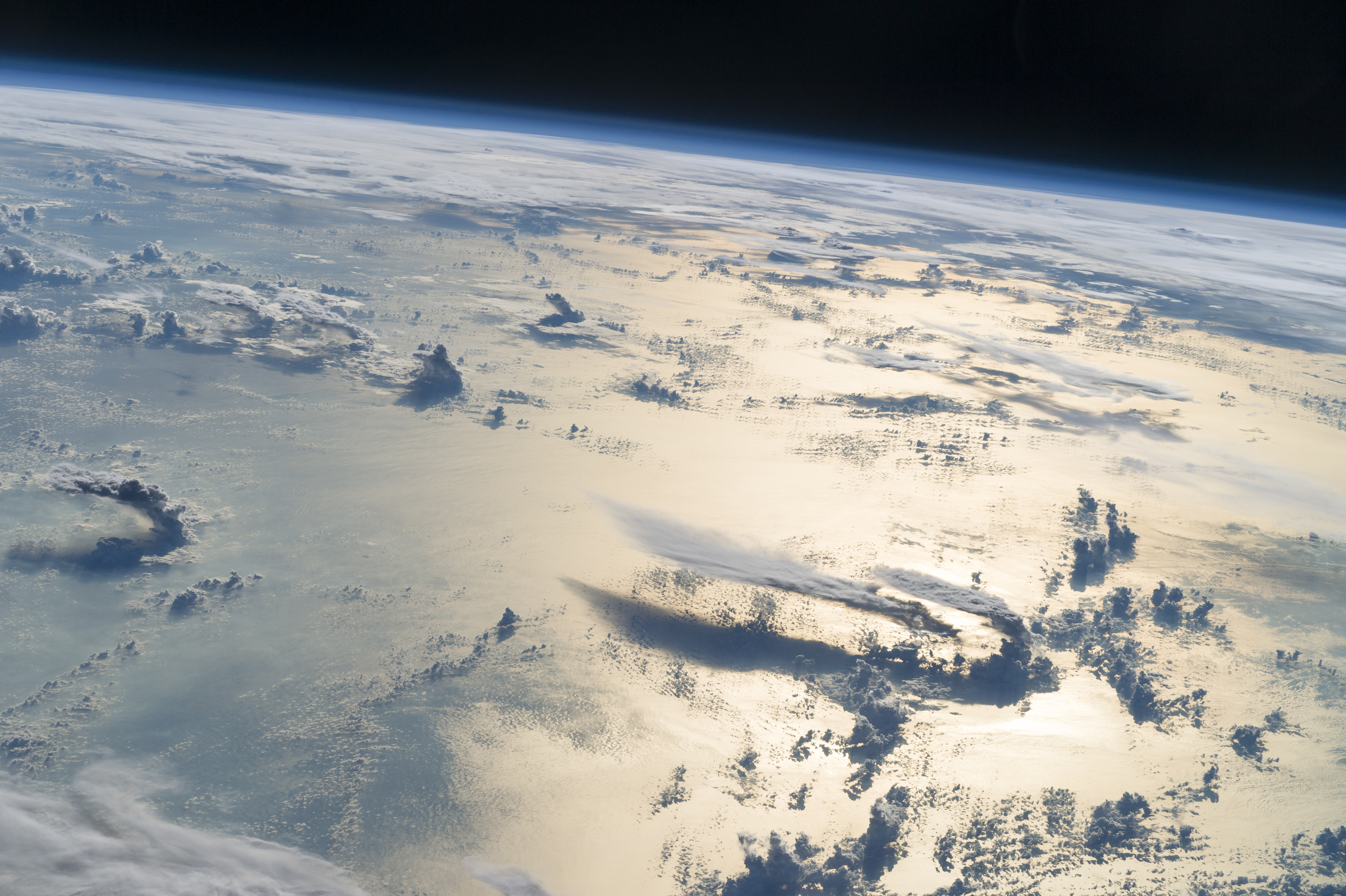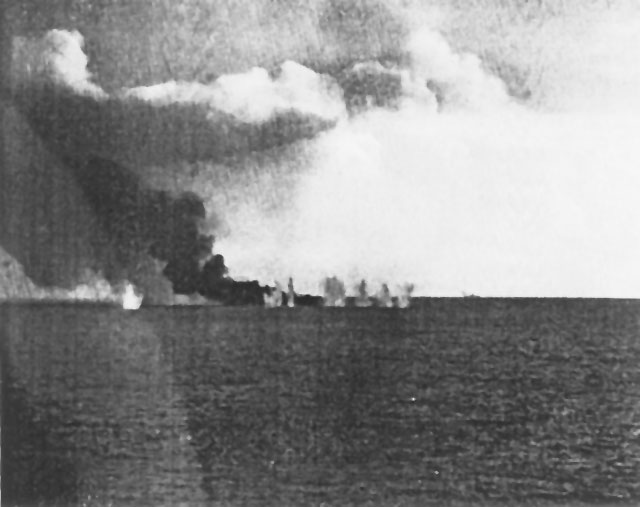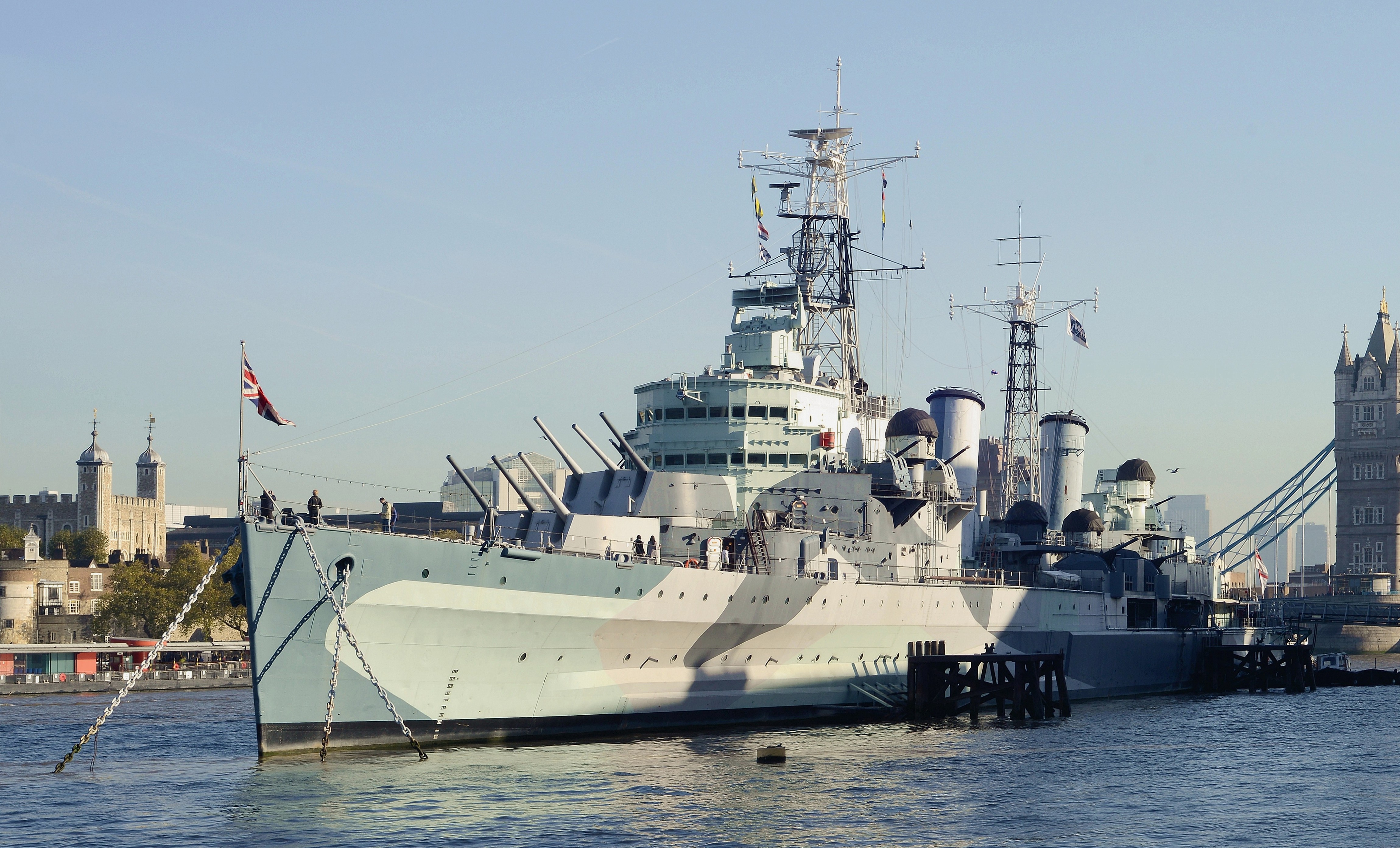|
Typhoon Cobra (1944)
Typhoon Cobra, also known as the Typhoon of 1944 or Halsey's Typhoon (named after Admiral William Halsey Jr.), was the United States Navy designation for a powerful tropical cyclone that struck the United States Pacific Fleet in December 1944, during World War II. The storm sank three destroyers, killed 790 sailors, damaged 9 other warships, and swept dozens of aircraft overboard off their aircraft carriers. Task Force 38 (TF 38) had been operating about east of Luzon in the Philippine Sea, conducting air raids against Japanese airfields in the Philippines and had been trying to refuel their ships. Information given to Halsey about the typhoon was incorrect, and despite warning signs of worsening conditions, the ships remained on station until December 17 when Halsey ordered the Third Fleet into the center of the typhoon. With currently available data, it was the 23rd and last known Western Pacific tropical cyclone formed during the 1944 season. Meteorological history ... [...More Info...] [...Related Items...] OR: [Wikipedia] [Google] [Baidu] |
Philippine Sea
The Philippine Sea is a List of seas#Marginal seas by ocean, marginal sea of the Pacific Ocean, Western Pacific Ocean east of the list of islands of the Philippines, Philippine Archipelago (hence the name) and the List of seas#Largest seas by area, largest sea in the world, occupying an estimated surface area of . The Philippine Sea Plate forms the floor of the sea. Its western border is the first island chain to the west, comprising the Ryukyu Islands in the northwest and Taiwan in the west. Its southwestern border comprises the Philippines, Philippine islands of Luzon, Catanduanes, Samar, Leyte, and Mindanao. Its northern border comprises the Japanese islands of Honshu, Shikoku and Kyūshū. Its eastern border is the second island chain to the east, comprising the Bonin Islands and Iwo Jima in the northeast, the Mariana Islands (including Guam, Saipan, and Tinian) in the due east, and Halmahera, Palau, Yap and Ulithi (of the Caroline Islands) in the southeast. Its southern ... [...More Info...] [...Related Items...] OR: [Wikipedia] [Google] [Baidu] |
USS Dewey (DD-349)
The first USS ''Dewey'' (DD-349) was a ''Farragut''-class destroyer of the United States Navy, launched in 1934 and named for Admiral George Dewey. ''Dewey'' served in the Pacific through World War II. After escaping damage during the Attack on Pearl Harbor, ''Dewey'' screened the aircraft carrier until the carrier was lost in the Battle of the Coral Sea; then screened through the Invasion of Guadalcanal and the Battle of the Eastern Solomons. Following overhaul in San Francisco, ''Dewey'' spent 1943 in Alaskan waters supporting the invasions of Attu and Kiska. ''Dewey'' spent 1944 supporting raids in the Marshalls, Carolines, and Marianas, including screening carriers during the Battle of the Philippine Sea. After being damaged by Typhoon Cobra during the Recapture of the Philippines, ''Dewey'' supported the invasion of Iwo Jima and spent the remainder of the war screening replenishment oilers. History ''Dewey'' was launched on 28 July 1934 by Bath Iron Works, Bath, Main ... [...More Info...] [...Related Items...] OR: [Wikipedia] [Google] [Baidu] |
USS Monterey (CVL-26)
USS ''Monterey'' (CVL-26) was an light aircraft carrier of the United States Navy, in service during World War II and used in training for several years thereafter. Originally laid down as light cruiser ''Dayton'' (CL-78) on 29 December 1941 by New York Shipbuilding, Camden, New Jersey, the ship was reclassified CV-26 on 27 March 1942 and renamed ''Monterey'' four days later, launched on 28 February 1943, sponsored by Mrs. Patrick N. L. Bellinger, and commissioned on 17 June 1943, Captain Lestor T. Hundt in command. It was the third US Navy vessel to be named after the Battle of Monterey. Future U.S. President Gerald R. Ford served aboard the ship during World War II. Service history World War II ''Monterey'' was reclassified CVL-26 on 15 July 1943, shortly before commissioning, and after shakedown, departed Philadelphia for the western Pacific. She reached the Gilbert Islands on 19 November 1943, in time to help secure Makin Island. She took part in strikes on Kavieng, N ... [...More Info...] [...Related Items...] OR: [Wikipedia] [Google] [Baidu] |
Naval Historical Foundation
The Naval Historical Foundation was a nonprofit organization founded in 1926 and disbanded in 2022. It had a broad mission to preserve and promote the naval history of the United States by supporting official maritime history programs and institutions, meeting the needs of the public for naval history, and collecting historical items. The foundation was located at the Washington Navy Yard in Washington, D.C. History Origins After World War I, many Americans took the view that the pre-war naval arms race between the United Kingdom and the German Empire had contributed to the outbreak of the war in 1914. This view led to opposition in the United States to postwar naval spending. After taking office in March 1921, President Warren G. Harding, influenced by pacifist thinking and seeing an opportunity to take advantage of anti-naval sentiment to reduce United States Government spending, invited representatives of the United States, the United Kingdom, the Empire of Japan, French Third ... [...More Info...] [...Related Items...] OR: [Wikipedia] [Google] [Baidu] |
Stuart H
Stuart may refer to: People *Stuart (name), a given name and surname (and list of people with the name) * Clan Stuart of Bute, a Scottish clan *House of Stuart, a royal house of Scotland and England Places Australia Generally *Stuart Highway, connecting South Australia and the Northern Territory Northern Territory *Stuart, the former name for Alice Springs (changed 1933) * Stuart Park, an inner city suburb of Darwin * Central Mount Stuart, a mountain peak Queensland *Stuart, Queensland, a suburb of Townsville *Mount Stuart, Queensland, a suburb of Townsville *Mount Stuart (Queensland), a mountain South Australia * Stuart, South Australia, a locality in the Mid Murray Council *Electoral district of Stuart, a state electoral district *Hundred of Stuart, a cadastral unit Canada *Stuart Channel, a strait in the Gulf of Georgia region of British Columbia United Kingdom * Castle Stuart United States *Stuart, Florida *Stuart, Iowa *Stuart, Nebraska * Stuart, Oklahoma *S ... [...More Info...] [...Related Items...] OR: [Wikipedia] [Google] [Baidu] |
President Of The United States
The president of the United States (POTUS) is the head of state and head of government of the United States. The president directs the Federal government of the United States#Executive branch, executive branch of the Federal government of the United States, federal government and is the Powers of the president of the United States#Commander-in-chief, commander-in-chief of the United States Armed Forces. The power of the presidency has grown since the first president, George Washington, took office in 1789. While presidential power has ebbed and flowed over time, the presidency has played an increasing role in American political life since the beginning of the 20th century, carrying over into the 21st century with some expansions during the presidencies of Presidency of Franklin D. Roosevelt, Franklin D. Roosevelt and Presidency of George W. Bush, George W. Bush. In modern times, the president is one of the world's most powerful political figures and the leader of the world's ... [...More Info...] [...Related Items...] OR: [Wikipedia] [Google] [Baidu] |
Gerald Ford
Gerald Rudolph Ford Jr. (born Leslie Lynch King Jr.; July 14, 1913December 26, 2006) was the 38th president of the United States, serving from 1974 to 1977. A member of the Republican Party (United States), Republican Party, Ford assumed the presidency after the resignation of President Richard Nixon, under whom he had served as the 40th vice president of the United States, vice president from 1973 to 1974 following Spiro Agnew's resignation. Prior to that, he served as a member of the U.S. House of Representatives from 1949 to 1973. Ford was born in Omaha, Nebraska, and raised in Grand Rapids, Michigan. He attended the University of Michigan, where he played for Michigan Wolverines football, the university football team, before eventually attending Yale Law School. Afterward, he served in the U.S. Naval Reserve from 1942 to 1946. Ford began his political career in 1949 as the U.S. representative from Michigan's 5th congressional district, serving in this capacity for nearly 25 ... [...More Info...] [...Related Items...] OR: [Wikipedia] [Google] [Baidu] |
Escort Carrier
The escort carrier or escort aircraft carrier (U.S. hull classification symbol CVE), also called a "jeep carrier" or "baby flattop" in the United States Navy (USN) or "Woolworth Carrier" by the Royal Navy, was a small and slower type of aircraft carrier used by the Royal Navy, the Royal Canadian Navy, the United States Navy, the Imperial Japanese Navy and Imperial Japanese Army Air Force#Army Escort-Aircraft Carriers, Imperial Japanese Army Air Force in World War II. They were typically half the length and a third the Displacement (ship), displacement of larger fleet carriers, more-lightly armed and armored, and carried fewer planes. Escort carriers were most often built upon a commercial ship hull, so they were cheaper and could be built quickly. This was their principal advantage as they could be completed in greater numbers as a stop-gap when fleet carriers were scarce. However, the lack of protection made escort carriers particularly vulnerable, and several were sunk with gr ... [...More Info...] [...Related Items...] OR: [Wikipedia] [Google] [Baidu] |
Light Cruiser
A light cruiser is a type of small or medium-sized warship. The term is a shortening of the phrase "light armored cruiser", describing a small ship that carried armor in the same way as an armored cruiser: a protective belt and deck. Prior to this smaller cruisers had been of the protected cruiser model, possessing armored decks only. While lighter and smaller than other contemporary ships they were still true cruisers, retaining the extended radius of action and self-sufficiency to act independently around the world. Cruisers mounting larger guns and heavier armor relative to most light cruisers would come to be known as heavy cruisers, though the designation of 'light' versus 'heavy' cruisers would vary somewhat between navies. Through their history light cruisers served in a variety of roles, primarily on long-range detached patrol work, covering other military operations or global shipping lanes, as scouts and fleet support vessels for battle fleets, as destroyer command ship ... [...More Info...] [...Related Items...] OR: [Wikipedia] [Google] [Baidu] |
Farragut-class Destroyer (1934)
The ''Farragut''-class destroyers were a class of eight 1,365-ton destroyers in the United States Navy and the first US destroyers of post-World War I design. Their construction, along with the , was authorized by Congress on 29 April 1916, but funding was delayed considerably. Limited to 1,500 tons standard displacement by the provisions of the London Naval Treaty of 1930, the ships were laid down beginning in 1932 and were completed by 1935. After 12 years since the last of the previous class of American destroyers (the ) was commissioned, the ''Farragut''s were commissioned in 1934 and 1935. These ships were slightly larger than their predecessors, faster, and they had only two stacks, versus the four stacks common to all the earlier classes. The class was the first of six classes of 1,500-ton destroyers built in the 1930s to modernize the United States Navy, and all eight ''Farragut''s saw extensive front-line service during World War II. None were lost in battle, although ... [...More Info...] [...Related Items...] OR: [Wikipedia] [Google] [Baidu] |
Destroyer
In naval terminology, a destroyer is a fast, maneuverable, long-endurance warship intended to escort larger vessels in a fleet, convoy, or carrier battle group and defend them against a wide range of general threats. They were conceived in 1885 by Fernando Villaamil for the Spanish NavySmith, Charles Edgar: ''A short history of naval and marine engineering.'' Babcock & Wilcox, ltd. at the University Press, 1937, page 263 as a defense against torpedo boats, and by the time of the Russo-Japanese War in 1904, these "torpedo boat destroyers" (TBDs) were "large, swift, and powerfully armed torpedo boats designed to destroy other torpedo boats". Although the term "destroyer" had been used interchangeably with "TBD" and "torpedo boat destroyer" by navies since 1892, the term "torpedo boat destroyer" had been generally shortened to simply "destroyer" by nearly all navies by the First World War. Before World War II, destroyers were light vessels with little endurance for unatte ... [...More Info...] [...Related Items...] OR: [Wikipedia] [Google] [Baidu] |
Cruiser
A cruiser is a type of warship. Modern cruisers are generally the largest ships in a fleet after aircraft carriers and amphibious assault ships, and can usually perform several operational roles from search-and-destroy to ocean escort to sea denial. The term "cruiser", which has been in use for several hundred years, has changed its meaning over time. During the Age of Sail, the term ''cruising'' referred to certain kinds of missions—independent scouting, commerce protection, or raiding—usually fulfilled by frigates or sloop-of-war, sloops-of-war, which functioned as the ''cruising warships'' of a fleet. In the middle of the 19th century, ''cruiser'' came to be a classification of the ships intended for cruising distant waters, for commerce raiding, and for scouting for the battle fleet. Cruisers came in a wide variety of sizes, from the medium-sized protected cruiser to large armored cruisers that were nearly as big (although not as powerful or as well-armored) as a pre- ... [...More Info...] [...Related Items...] OR: [Wikipedia] [Google] [Baidu] |








